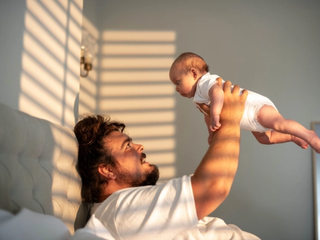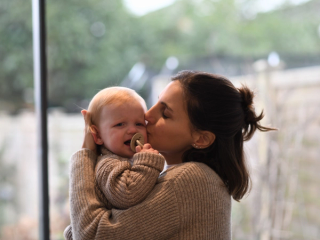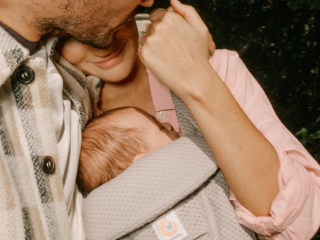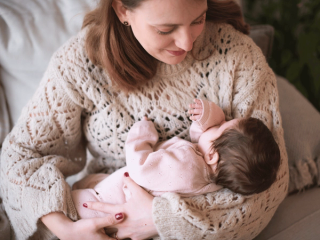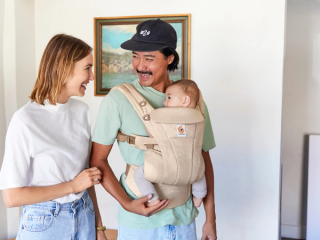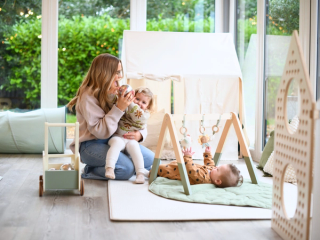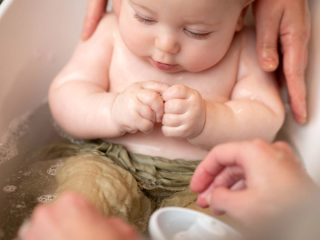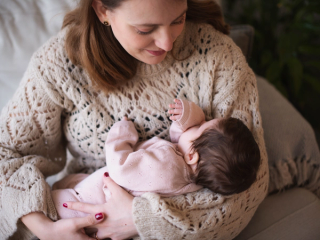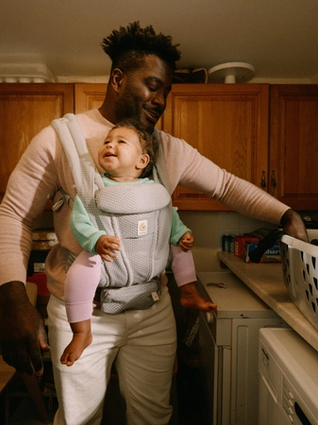
- Home
- Advice Hub
- Newborn
- New Parent Support
- Five Things To Know Before You Start Using A Baby Carrier
Five things to know before you start using a baby carrier
Learn when to start babywearing, how to pick the right carrier, safe carrying positions, and expert babywearing tips in this guide.
Babywearing is a great way to carry your baby while keeping your hands free, giving you the freedom to go about your day while giving your baby the comfort of being close to you in a safe and secure position. In this article, we’re answering the top 5 questions around babywearing, including when you can start using a baby carrier, whether a baby carrier is safe for newborns, plus any safety concerns.
1. When can you start using a baby carrier?
Baby carriers are safe from day one, if they have the right ergonomic support and they meet the height and weight requirements. For example, our Embrace carriers are suitable from 7 lb and our Aura Wrap is suitable from 8 lb. Baby carrying is a great way to bond with your new baby, providing the benefits of skin-to-skin contact while leaving your hands free to do all the many jobs that seem to crop up when you have a baby!
2. What type of baby carrier should I use?
There are lots of baby carriers on the market – from wraps to slings to hip seat carriers. The best baby carrier for you will depend partly on when and how you want to use it, so do your research or better yet find your local sling library and try before you buy.
3. What are the different baby carrying positions?
The main baby-carrying positions are: front inward facing, front outward facing, hip carry and back carry. Always check your carrier’s guidelines before you put your baby into position, but as a general rule we suggest:
- Inward facing is suitable for 0+ months (as long as baby weighs 7lbs).
- Outward facing is suitable for 5 – 6+ months.
- Hip carry is suitable from 6+ months.
- Back carry is suitable from 6+ months.
We have a range of different carriers – some of which can be used in multiple ways, but others are designed for specific ways of carrying your baby, such as the Hip Seat Carrier. If you are not sure which carrier to start with, we can recommend an Embrace as it’s specially designed for newborns and a great introduction to babywearing, or our Omni Deluxe for a great all-rounder that can be used from birth without a newborn insert all the way through toddlerhood (up to 45lbs) and allows all four carrying positions.
It's important not to rush into the outward facing carry as your little one’s neck needs to be strong enough to hold up their head and they need to be tall enough for their chin to clear the panel. Outward facing can also be a bit overwhelming for young babies and is not suitable for sleeping. See the full checklist to know when they’re ready here.
Hip carrying and back carrying both have different benefits. Hip carrying is useful for older babies who are constantly up and down, while back carrying is great for curious explorers who want to see the world but are getting too heavy for front carrying!
4. Is babywearing safe?
Babywearing is safe, so long as you follow the guidance. Here are the do’s and don’ts of baby carrier safety:
Do carry your baby in the correct position.
Your baby carrier will come with guidance, which you should follow. Keep your baby sitting upright with their neck fully supported, airways visible and clear, chin off their chest, as well as close against you and high up on your torso (you should be able to easily kiss their head). Check out this article on correct positioning.
Do sit baby in an ergonomic position.
Your baby should be sitting in a natural squat-spread - or M-shaped - position with their knees above their bottom. This ergonomic position supports the spine, hips and legs and helps to prevent hip dysplasia.
Do secure all carrier fasteners.
Make sure that buckles, buttons etc. are tight and securely fastened. Lots of our carriers have extra elastic loops near where the buckles close to create an extra level of safety.
Do check fabric for wear and tear.
Tears or holes can make a baby carrier unsafe. If you notice anything, please contact our customer service team.
Don't dress your baby too warmly.
Your baby can quickly become too warm due to the close proximity to the body in the carrier. Take into account the time of year, outdoor and indoor temperatures (depending on where you are travelling), your own clothing and your planned activities to dress your baby appropriately. Remember: the baby carrier counts as an extra layer of clothing and your body heat can also act as a heater.
Don’t lie down while using a baby carrier.
Babies need to stay in an upright position in their baby carrier, so if you need to lie down, take your baby out of their carrier first.
Don’t let baby sleep while facing outwards
Once baby reaches the appropriate developmental milestones (see above) they can face outwards in your baby carrier. However this is only safe while baby is awake so please turn them back around to face you if they start to get sleepy.
Don’t use a baby carrier while biking, skiing, snowboarding, etc.
Light physical activities such as walking, hiking and suitable fitness exercises are fine.
Don’t drink hot liquids or eat hot foods.
Biscuit crumbs on your baby's head are not a problem, but hot coffee or soup etc. could injure their sensitive scalp. Pay attention to what you eat and drink when babywearing.
Do be more cautious and alert.
Because your centre of gravity changes when you wear your baby, your chances of falling can increase. Be more aware of your surroundings and careful when on or nearby stairs, slippery surfaces, curbs and other tripping hazards.
5. Practice using the baby carrier before putting your baby in it.
Whatever carrier you choose, practice using it before baby arrives to help you get used to it!
Should I use a baby carrier?
Yes! If the free hands don’t sell it to you, the offroad adventures should. A baby carrier is a great way to connect with your baby – supporting their needs, while also enabling you to meet yours.
Advice & tips

Want to read more? Join the HiPP BabyClub for full access to this article.
As a BabyClub member, you'll get access to a range of exclusive benefits, including:
Monthly competitions
Discounts from our Partners
Expert advice tailored to your little one's age
Weaning recipes
HiPP shop discounts*
*10% off HiPP's online shop does not apply to our First Infant, Anti-Reflux or Comfort Formula Milk.
Important notice: Breastfeeding is best. Follow on milk should only be used as part of a mixed diet from 6 months. Talk to a healthcare professional.




